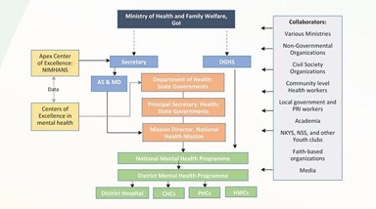Published on: November 26, 2022

National Suicide Prevention Strategy
National Suicide Prevention Strategy

Why in news?
The Ministry of Health and Family Welfare unveiled the National Suicide Prevention Strategy the first-of-its-kind policy formulated by the government to prevent suicides as a public health priority.
Highlights:
What is India’s National Suicide Prevention Strategy?
- The policy that will set the stage for promotion of mental health and prevention of suicides in the coming decade.
- The goal of the strategy is to reduce suicide mortality in the country by 10 per cent by 2023.
- The strategy provides a framework for multiple stakeholders to implement activities for prevention of suicides in the country.
What are the objectives of policy ?
- It seeks to establish effective surveillance mechanisms for suicide within the next three years.
- To establish psychiatric outpatient departments that will provide suicide prevention services through the District Mental Health Programme in all districts within the next five years.
- It aims to integrate a mental well-being curriculum in all educational institutions within the next eight years.
- Strengthen surveillance of suicide and further generation of evidence through evaluation, that will ensure improvement in the programme quality.
Who are the Stakeholders?
The implementation has five key stakeholders responsible for realising the objectives.
- These include national-level ministerial stakeholders, state-level governmental stakeholders, district-level governmental stakeholders, NIMHANS-Bangalore and other top mental health institutes, and strategic collaborators.
Implementation mechanism
- Reinforcing leadership, partnerships and institutional capacity in the country
- Enhancing the capacity of health services to provide suicide prevention services
- Developing community resilience and societal support for suicide prevention and reduce stigma associated with suicidal behaviours.
Suicides in India: What’s the current scenario?
- The NCRB report stated that more than 1,00,000 people die by suicide in the country every year.
- A total of 25,891 suicides were reported in the 53 megacities of the country during 2021, with the highest in Delhi.
- In the past three years, the suicide rate in the country has increased from 10.2 to 11.3 per 1,00,000 population. Most suicides in India are by youth and middle-aged adults — with 65 per cent of the suicides in 2020 being reported in the age group of 18-45 years
What are the Ongoing suicide prevention initiatives in India?
- National Mental Health Policy (2014): Sees prevention of mental disorders, reduction of suicide and attempted suicide as core priority areas.
- Mental Healthcare Act 2017: Effectively decriminalised attempted suicide, which was punishable under Section 309 of the Indian Penal Code.
- It ensured that the individuals who have attempted suicide are offered opportunities for rehabilitation from the government as opposed to being tried or punished.
- National Palliative Care Program: It improves the quality of life of patients and families who face life-threatening illness, by providing pain and symptom relief, spiritual and psychosocial support from diagnosis to the end of life and bereavement.
- KIRAN : Ministry of Social Justice and Empowerment has launched a 24/7 toll-free helpline to provide support to people facing anxiety, stress, depression, suicidal thoughts and other mental health concerns.
- Manodarpan: It is aimed to provide psychosocial support to students, family members and teachers for their mental health and well-being during the times of Covid-19.
- Nasha Mukti Abhiyaan Task Force: Intensive anti-drug campaign for preventive, mass education and sensitization, capacity building of service providers for drug free campaign

